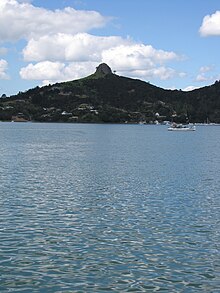Whangaroa Harbour


Whangaroa Harbour (
There are extensive mangrove swamps at the head of the harbour,[5] and some of the oldest fossils in the North Island, dating to the Early Permian about 270 million years ago, are in the Whangaroa area.[6]
History
According to Māori traditions, the
A Wesleyan mission was founded in June 1823.[10] Hongi Hika attacked local Māori to gain control of millable kauri on 10 January 1827. A party of his warriors, without his knowledge, ransacked the mission and it was abandoned.[11] In 1828 Hongi Hika died at Whangaroa, from a wound suffered 14 months earlier in the Hokianga.[5]
Europeans settled the harbour in the 1840s, and a Catholic mission was established at Waitaruke. The harbour was a centre for timber milling and
After the

Education
Both schools are coeducational. Other schools in the area are at Oruaiti, Kaeo and Matauri Bay. 35°3′0″S 173°44′0″E / 35.05000°S 173.73333°E
Notes
- ISBN 0-7900-0952-8.
- ISBN 1-877333-20-4.
- ISBN 0-473-00387-2.
- ^ "Whangaroa Harbour". Te Ara: The Encyclopedia of New Zealand.
- ^ a b c "Whangaroa and district". Te Ara: The Encyclopedia of New Zealand.
- ^ "Oldest fossils – Paleozoic". Te Ara: The Encyclopedia of New Zealand.
- ^ "Ngāti Whātua - Origins". Te Ara: The Encyclopedia of New Zealand.
- ^ "Ngāti Kurī, Ngāi Takoto, Te Pātū and Ngāti Kahu". Te Ara: The Encyclopedia of New Zealand.
- ^ Encyclopedia of New Zealand (1966).
- Encyclopedia of New Zealand (1966).
- ^ "The Church Missionary Gleaner, March 1867". Wangaroa, New Zealand. Adam Matthew Digital. Retrieved 24 October 2015.
- ^ "Auckland shipbuilding trade. New Zealand Herald". paperspast.natlib.govt.nz. 11 June 1887. Retrieved 28 March 2024.
- ^ "Lane & Brown Shipyard and Sawmill". nzhistory.govt.nz. 2013. Retrieved 28 March 2024.
- ^ "49 Okura Bay Rd". Google Maps. February 2013. Retrieved 28 March 2024.
- ^ "Moving kauri: dams and rafting". Te Ara: The Encyclopedia of New Zealand.
- ^ "Te Kete Ipurangi - Te Kura o Hato Hohepa Te Kamura". Ministry of Education.
- ^ "Te Kete Ipurangi - Totara North School". Ministry of Education.

